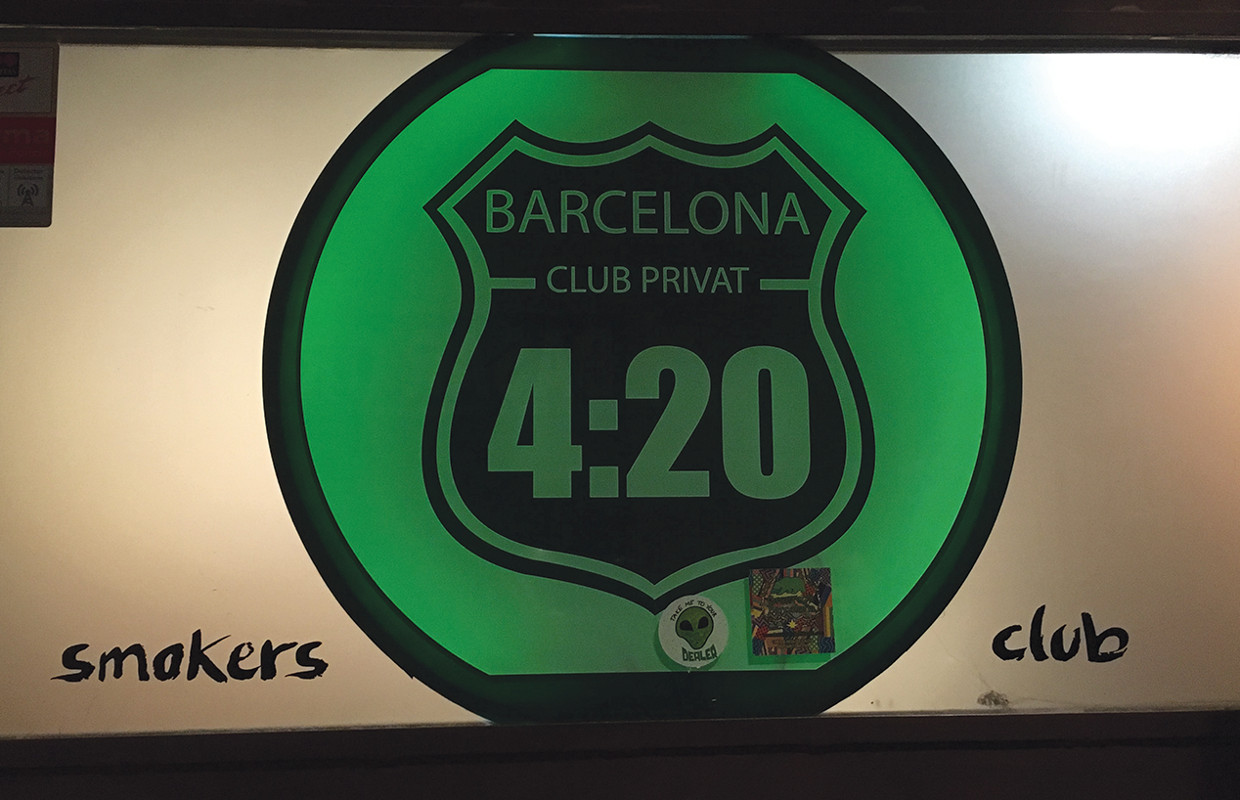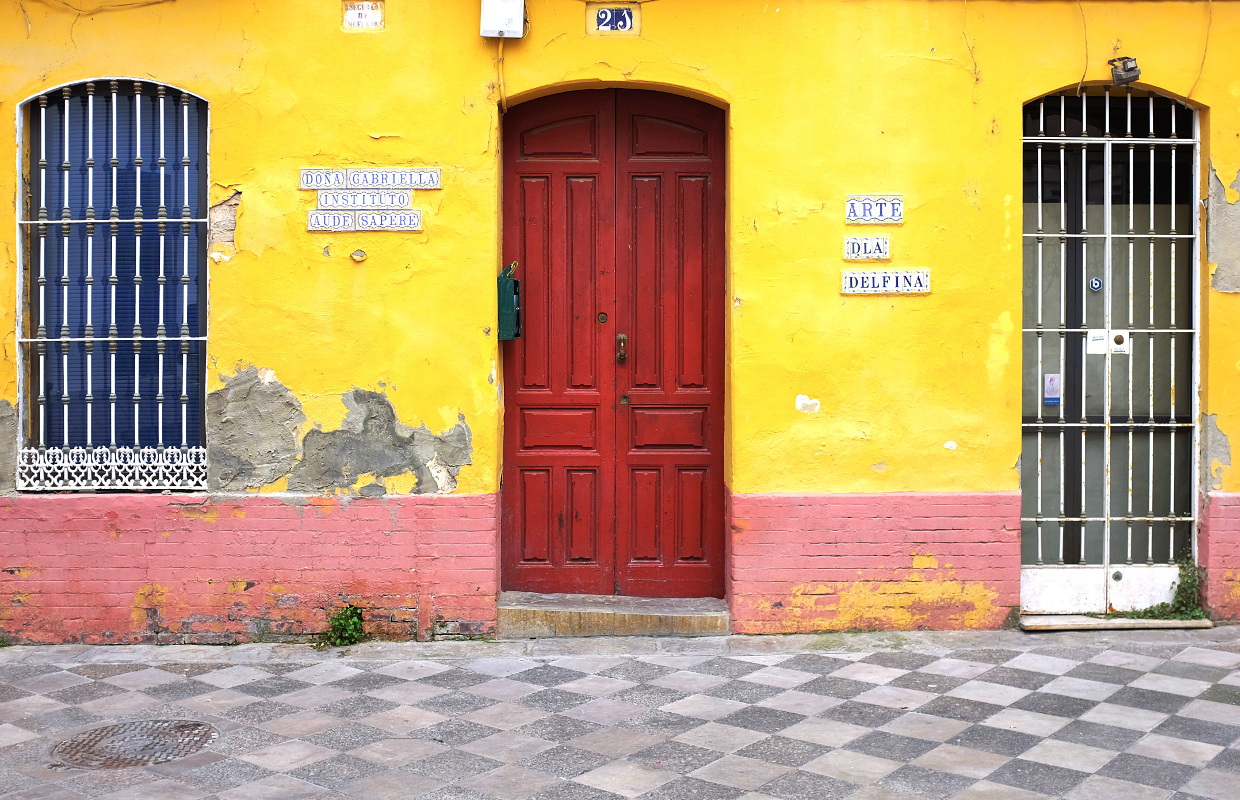Stumbling Upon Bud in Barcelona: Outlaw Vistas in Spain
Barcelona, Spain, boasts some of the most picturesque architecture and views in the world and is home to several members-only cannabis clubs.
We stumbled upon our first cannabis club while wandering after midnight through the winding, cobblestone streets of Plaza Reial, near Barcelona’s famed Las Ramblas.
A friend had flown in from Turkey to meet me, and were on our way to a grunge club called Nevermind that has an indoor skate park, when I noticed my favorite number bearing down on me above an imposing door: Apparently, this was the 420 Club.
It was so late, I assumed it must be closed, but suddenly the door opened, and a man in his forties stepped out. I approached him with laughter and surprise, telling him that I was a ganja journalist from California, and that I would love to check out the club, even though I wasn’t a resident. He reminded me that even as a foreigner, I could still enjoy the club, provided I had an invitation from a member.
“Well, you’re a member, right?” I asked coyly in Spanish.
“Me?” He laughed. “I’m the president. Come in. Be my guest.”
Ahh, Barcelona: the land of dreamy, gothic architecture, pristine, clothing-optional beaches, and a quarter of Spain’s quasi-legal cannabis clubs.
Barcelona boasts over 200 members-only lounges serving close to 200,000 members. Since the early naughts, when Spain’s Supreme Court ruled that possession – even of large quantities – was not a crime as long as it was non-profit and for personal use, cannabis clubs have proliferated throughout Spain, but especially in Barcelona.
Although Spain prohibits the sale of cannabis, there are no laws against private consumption and there’s a prevailing attitude that what people do in private is no business of the government. On that basis, growing a few plants for personal use is also allowed, as is the sale of seeds.
On my first day in this magical city, my travel mate and I told the cabbie to drop us off in Las Ramblas. “Rambla,” as it’s known locally, is a lively, touristic area of the city that’s full of sidewalk cafes and avant-garde street performers dressed in unimaginable costumes, even apparently sitting mid-air, Indian style. It’s also home to the city’s highest concentration of cannabis clubs, many of which cater to foreigners.

The scene is so different than either Amsterdam or California. In Amsterdam, there are cafes, yes, but the weed available to foreigners is comparatively low-quality and concentrates are outlawed. In California, we have ridiculously high-quality bud and the most innovative concentrates, but almost no place to consume and socialize together. Barcelona is the best of both worlds: great buds and concentrates in both the BHO and solventless categories, and a chill place to come together and relax.
Later after midnight, the owner of the 420 Club we befriended led us past a group of college boys playing Xbox, some other 20-somethings watching a movie on a giant screen and a couple conversing on a comfortable-looking sofa with drinks. Toward the back there was a young budtender, sitting behind a display case stocked with about a dozen strains of flower and five types of concentrates. He offered me his favorite, some blond BHO shatter, to inspect. “Do you have anything that’s solvent-free?” I asked, and he recommended some CO2 options. I was encouraged to take my time smelling and otherwise perusing anything that piqued my interest. Prices were on par with California’s, averaging $15 for a gram of flowers and $20 for an equal amount of hash.
From a structural standpoint, Barcelona’s cannabis clubs are similar to medical collectives and dispensaries in California: they must be membership-based, there are limits on how much one may obtain (roughly three ounces per month in Barcelona) and they must be non-profit. In both places, “selling” cannabis is illegal; nevertheless, each item has a set price. Barcelona’s members pay a nominal annual fee (around $30) and any additional monies paid are known as “reimbursement” for expenses surrounding procuring the cannabis and the upkeep of the club. In California, collectives accept “donations” in lieu of payment. The concept is the same.

But California’s dispensaries do just that – they dispense cannabis. Rare is the pot shop that offers on-site consumption in the Golden State. Barcelona’s clubs, on the other hand, are designed for lounging. Some have giant screens and expansive DVD collections, Xbox, pool tables and juice bars. While others are more Spartan, offering little more than chairs and couches, some are pretty chic, serving drinks and snacks to members as they socialize or work on their laptops.
Barcelona’s pot scene still exists in the golden age of the grey area, where regulations have not yet caught up to cannabis clubs, and, as a result, there are few hard and fast rules of engagement. And just as Spain – where cannabis remains illegal at the federal level – doesn’t tend to meddle in local affairs and leaves states largely to govern themselves, Barcelona leaves it up to cannabis clubs to set many of their own rules. As a result, there’s no set age requirement – as long as members are over 18 – although some clubs have a minimum age requirement of 21. Ostensibly, membership is open only to residents of Spain, but one need only provide a local address to “prove” their residency, and many clubs accept international passports as valid ID. In stricter clubs, you must be invited by another member. In the most permissive ones, you can solidify your membership online or by phone.
In spite of the plethora of options to consume freely in the clubs, it is very tempting to light up in this beautiful city’s famously magnificent public spaces, and the smell of bud wafting through the cobblestone streets is not uncommon. Barcelona is indeed one of the dreamiest places to get high. The darkly whimsical architecture of Gaudi, whose alleged fondness of psychedelic mushrooms is quite apparent in his work, makes much of the city feel like an underwater daydream.
Endless fun can be had getting lost among the winding cobblestone streets in the Gothic Quarter, stumbling upon hidden gems like the cozy Mediterranean teahouse with the stone interior walls, or exploring the narrow passageways that open unexpectedly into sprawling plazas with towering, greystone, centuries-old churches that look more like Dracula’s castles.
Park Guell, designed by Gaudi, is full of his famously wavy structures and is home to a 360-degree panoramic view that spans all the way out to the Mediterranean Sea. More enchanting views can be had from the summit of Mt. Tibidabo, where a century-old church with elegant spires towers unexpectedly over one of the oldest operating amusement parks in the world. There are also beguiling vistas from the towers at Sagrada Familia, the Gaudi temple that looks like an imaginary castle from a gothic fairytale on an ancient, forgotten planet.
Being in Barcelona makes it hard to follow the laws against public consumption; it seems not to light up in a place like this would be a crime. Since indulging in public is a low law enforcement priority, there’s little to worry about, and there’s a sense that things are about to get even more permissive in Barcelona soon. The clubs dodged a bullet this summer when the city’s first female mayor decided not to follow through with her predecessor’s plan to close all but a handful. With regulations finally forthcoming, I expect Barcelona to become even more relevant as a cannabis destination with views worth breaking the law for.
Originally published in Issue 23 of Cannabis Now. LEARN MORE.

























